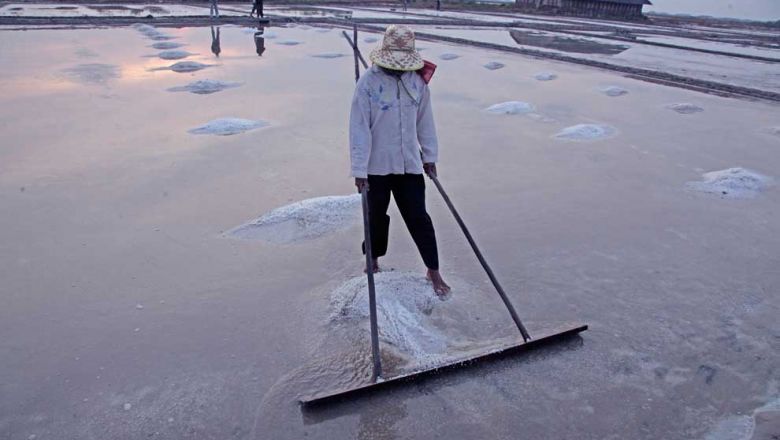GI-certified ‘Kampot Pepper’ proving spicyc
GI-certified ‘Kampot Pepper’ proving spicyc
The harvest of geographical indication (GI) certified “Kampot Pepper” has reached about 30 per cent, while much of the expected crop for this season has been ordered by exporters, according to Kampot Pepper Promotion Association (KPPA) president Nguon Lay.
A GI is an intellectual property (IP) tool that protects products originating or otherwise strongly linked to a specific geographical region and that possess particular qualities, reputations or other characteristics fundamentally attributable to their territory of origin. GI products are generally accompanied by a managing association, as well as a name, sign or symbol to distinguish them from unauthorised versions.
Each year, peppercorn – the fruit of the Piper nigrum, a flowering vine considered to be native to the southwestern Indian coast – is typically harvested exclusively by hand between January and June, generally wrapping up when the southwest monsoon brings the rainy season from mid-May.
Among the varieties cultivated in the Kingdom, Kampot pepper – grown in the namesake coastal province – is the most highly prized and remains the sole type protected under national GI legislation. The KPPA is in charge of managing Kampot pepper.
The KPPA’s Lay, speaking to The Post on May 3, said the Kampot pepper harvest usually takes place from early January to early July, noting that peak production season falls between May and early July, as red and white pepper require additional time for ripening or maceration.
He explained that the average per-kilogram rates of red and white pepper are $25 and $28, respectively, far higher than the $15 price tag for black pepper, making them a more attractive option for many growers. These three rates have remained the same since 2015, he noted, estimating the annual yield of peppercorn at about 100 tonnes.
Despite the relatively slow pace of the harvest, most of the expected crop from small- and medium-holder farmers has been ordered by exporters, principally through contract farming, Lay said, adding that most large-scale growers tend to wait until their peppercorn has been collected to then market it themselves.
On April 26, coinciding with World Intellectual Property Day, the Ministry of Commerce “launched” three new GIs and four “collective marks”, at a ceremony representing formal recognition of the seven products’ inclusion into the Cambodian registry as well as the accompanying protections. Among these was the GI “Kampot-Kep Salt”.
With salt and pepper commonly used as tableside condiments, as Kampot-Kep salt gains wider popularity in the marketplace and attracts more buyers, demand for Kampot pepper too will increase, Lay claimed, pointing out that both products have GI status.
“Europe, the US, [South] Korea and Japan are the main target markets for Kampot pepper,” he said, sharing that with favourable weather, 1ha of land – which can viably support about 2,500 vines – could produce around 1.5 tonnes of Kampot pepper.
Cambodian Pepper and Spices Federation (CPSF) president Mak Ny said the average price of standard – non-GI – peppercorn has dropped from 14,000 riel ($3.50) in 2022 to 12,000 riel in 2023, which he generally blamed on the current set of economic and political crises confronting the world. However, exports have not run into any significant problems, he claimed.
“The declining incomes of each household have pushed down the price of Cambodian pepper this year compared to last year. Nonetheless, prices are up a bit now compared to the beginning of the year,” he said.
Prior to the Covid-19 pandemic, the nearly 7,000ha nationwide dedicated to the production of non-GI pepper could produce 17,000-20,000 tonnes per annum, but this cultivation area has decreased by about 10-20 per cent since then, Ny mentioned in a previous interview.
“Pepper cultivation is almost all aimed at meeting export demand. Domestic consumption accounts for just five to seven per cent of our annual production,” he noted.
The Ministry of Agriculture, Forestry and Fisheries reported that peppercorn exports reached 822.65 tonnes in the first quarter of 2023, which went to 12 markets.
Vietnam was by far the biggest buyer at 765 tonnes, followed by the US (26.14 tonnes), South Korea (16.2 tonnes), France (9.54 tonnes), Belgium (2.36 tonnes), Japan (1.38 tonnes), India (0.96 tonnes), Germany (0.90 tonnes), Singapore (0.10 tonnes), Taiwan (0.04 tonnes), Australia (0.03 tonnes) and Malaysia (0.002 tonnes).














